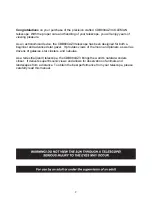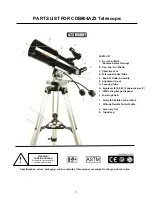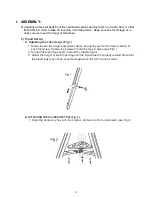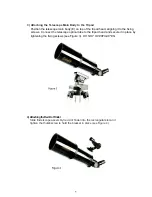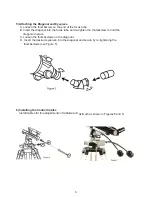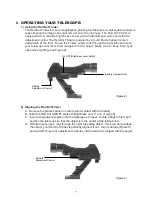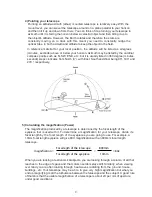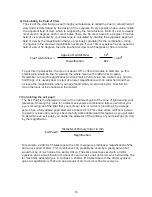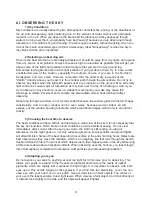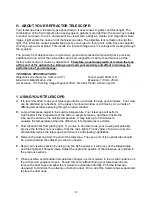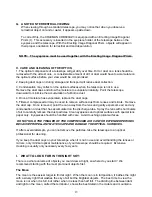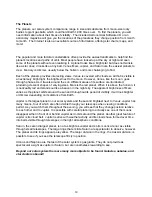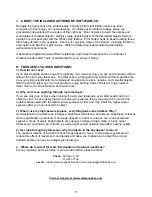
15
J.
ABOUT THE INCLUDED ASTRONOMY SOFTWARE CD
:
Navigate the heavens like the professionals. TheSkyX First Light Edition makes an ideal
companion to best enjoy your new telescope. Its intuitive user-interface always keeps you
grounded while exploring the wonders of the night sky. Point and click to learn the names and
coordinates of celestial objects. Quickly create observing lists of the interesting objects that are
visible from your backyard with the What’s Up? feature. Print finder charts to assist locating those
faint, fuzzy objects in the eyepiece. Zoom in for up-close views of the planets, including the Moon,
and Jupiter and Saturn’s major moons. Watch animated tours demonstrating fascinating
astronomical phenomena.
A descriptive digital user guide offers helpful tips, and in-depth descriptions on hundreds of
celestial wonders offer hours of edutainment for you and your family.
K. FREQUENTLY ASKED QUESTIONS:
1) How far can I see?
If you stand outside and look up at the night sky on a clear evening, you can see hundreds of stars
without the aid of your telescope. The telescope is a light-gathering instrument that magnifies the
view—providing significantly more detail and unveiling more stars, nebulae, and celestial objects.
With the aid of a telescope, you will be able to enjoy exciting views of Saturn’s rings, Jupiter’s
major moons, the Orion Nebula, and much more.
2) Why can’t I see anything through my telescope?
If you see only gray or black when looking through your telescope, even after searching for an
object to view, it is very likely that you are using an eyepiece that is too powerful. To solve this
problem always start with the lowest power eyepiece at first, and only insert the higher-power
eyepiece after you have located an object.
3) When I use my high-power eyepiece, everything looks much darker. Why?
As magnification in a telescope increases, brightness diminishes. Conversely, brightness increases
when magnification is reduced. If an image appears too dark or unclear, use a lower-powered
eyepiece. Views of small, bright objects are superior to those of large, dark, or blurry ones!
Atmospheric conditions, air currents, as well as light and air pollution also affect viewing quality.
4) As I look through my telescope, why do objects in the sky appear to move?
The constant rotation of the Earth makes things appear to move. Lower-power eyepieces will
reduce this effect of movement considerably and allow you to observe an object for a longer
duration before you have to readjust your telescope.
L. Whom do I contact for more information and product questions?
For any inquiries, parts, warranty or service information, please contact:
Phone:
800-441-1100
212-947-7100
e-mail:
or
Visit our website at www.colemanoptics.com
Содержание CDB804AZ3
Страница 16: ...16 Made in China ...


